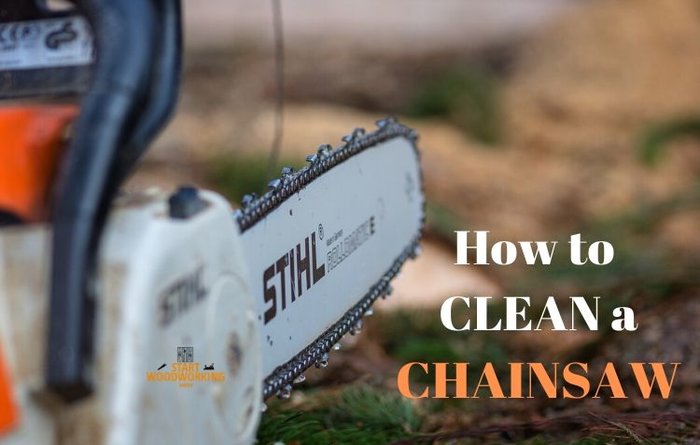How to Clean a Chainsaw [Easy Guide]
Your chainsaw also needs cleaning! Knowing how to clean a chainsaw helps to protect it from wear and extend its service life. Learn how to clean a chainsaw with these simple steps.
How to Clean a Chainsaw
Tools required:
The tools you need to clean your chainsaw include:
- Wire brush
- A lubricant or degreaser
- A universal cleaner
- A cleaning tool for bar grooves (e.g. a knife)
- Warm water
- A cleaning tool for oil holes (e.g. flat-head screwdrivers)
- Air compressor (optional)
- Cleaning method
Prepare your chainsaw for cleaning
The very first step is to prepare your chainsaw to clean it:
If you have an electric chainsaw, all you have to do is disconnect it from the power source.
If you have a cordless chainsaw, be sure to remove the battery before cleaning.
However, if you have a gas powered chainsaw, you must first drain the fuel.
Remove the bar and chain
Use the wrench to loosen the nuts on the sides of the rod.
This will separate the bar and chain from the chainsaw sprocket. You must ensure that the chain brake is already released before removing the bar and chain.
Step 1: How to Clean the Chainsaw Chain
Cleaning the chainsaw chain from the accumulations of dirt that has formed inside the lanes is essential to prevent the increase in temperature and a faster wear than the normal state of wear.
- To do this, simply loosen the chain, remove the chain cover and clean it with the help of a air compressor and a stiff bristle brush.
- If the dirt is very resistant, you can dip the chain in a little petrol or acetone and try again.
- Once the chain has been cleaned, we recommend that you also use the air compressor to remove surface debris from the clutch, flywheel and engine cooling fins.
Step 2: How to Clean a Chainsaw Bar
This operation is underestimated in my opinion, because having a well maintained and clean chainsaw bar means that the chain lubrication takes place in an optimal way.
Once removed we will see the sliding channels of the chain, looking carefully at the rear of the bar inside the channel, we can see two small passages that lead to the outside (one on each side).
In the two images you can see the two holes and the top view of the canal.
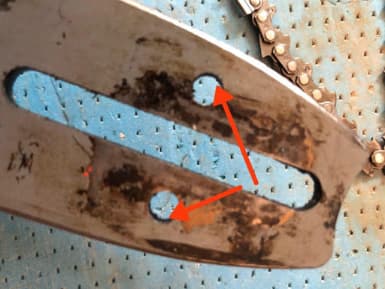
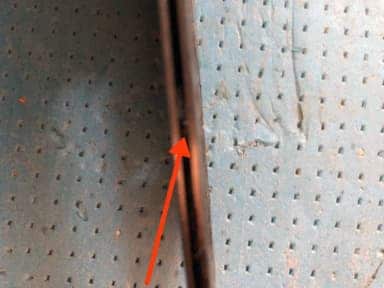
These two through holes are very important, because oil passes through them to lubricate the chain.
To be able to clean the channels and these through holes we can use an iron wire, scraping away everything that has settled inside the channels.
Eventually it will be necessary to uncork the through holes since they very often become obstructed, being very small and narrow.
If the deposit of dirt is difficult to eliminate, we can facilitate cleaning by using a degreasing agent to soften everything; we can use petrol or another type of degreaser to be sprayed in the channels and leave for a few minutes, then carry out another step with the iron wire or a thin blade.
Once the channels have been cleaned, it is possible to pass compressed air inside to expel the residues, this operation must be carried out especially if you notice that the chain does not lubricate properly during use.
If it does not lubricate, with the chainsaw disassembled (removing the bar and the chain) try to turn it on and accelerate, checking that the oil comes out of its exit hole.
If nothing comes out, the problem could concern the tube that connects the hole to the oil pump (dirt, clogging, deterioration) or it could be due to a failure of the oil pump itself.
Cleaning a chainsaw bar is not easy, it depends on the chainsaw you own, for this advice to those who are not very familiar with mechanical work, not to do this operation at home but to take it to a specialized shop.
The fact that the oil pump is blocked or the pipes are sometimes blocked depends on the type of oil used to lubricate the chain, very often if the oil is of poor quality it leaves residues inside the pipes especially in case of long periods of non-use.
Therefore I recommend not to save on the quality of the oil because it is really important for the correct functioning of your chainsaws.
Step 3: How to Clean a Chainsaw Air Filter
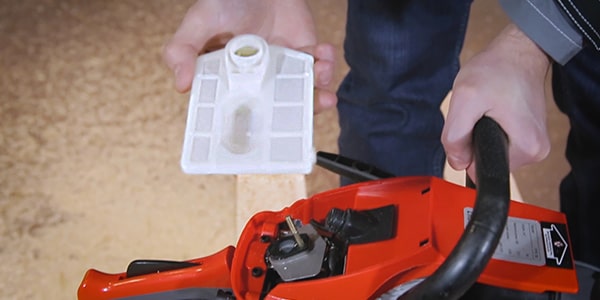
The air filter is the part of the chainsaw where the greatest amount of dust and waste is collected. Precisely for this reason, the ideal would be to clean the chainsaw air filter after each cutting operation.
Before removing the component and cleaning it, however, make sure that the closing command of the air butterfly valve is active, in order to avoid the entry of further dirt into the intake duct.
Apply some pressure with your fingers on the nozzle and blow the air inside with the compressor.
Compressed air is the most effective method of sanitizing mesh or paper filters , as long as you carefully dose their power, in order to avoid breaking the retina.
In case of persistent dirt, remove residues with the help of a soft bristle brush.
Bring work gloves and transparent protective goggles and wear them during all cleaning phases, to avoid getting dirty and incurring irritations and dust allergies.
Step 4: How to Clean a Chainsaw Carburetor
Cleaning the carburetor of the chainsaw is a very delicate operation :
The membrane structure with which it is equipped risks breaking easily and too aggressive maintenance could lead to irreparable damage to the carburetor.
The chainsaw carburetor should be cleaned according to the following steps:
- First you need to drain the remaining fuel from the fuel tank. We remove the chainsaw cover by unscrewing the fasteners. We take out the filter and disassemble the case, removing the nuts and fasteners if necessary.
- Remove the fuel mixture supply hose from its retainer, unscrew the fasteners of the carburetor top cover. Then we remove the top cover and the blue gasket – this is the membrane of the fuel pump. To the left of the case are the spring brackets, remove them, and then the screws. It is advisable to sign the parts and schematically fix the places from which they were removed so as not to confuse anything at the time of assembly.
- Remove the bottom cover of the carburetor, unscrew the screw and remove the needle valve and spring under it. Then, with a longitudinal force, we remove the air damper and its axis.
- Remove the throttle plate, drive arm and throttle axle.
- We lay out all the removed carburetor parts on a flat surface and conduct an inspection for integrity. Highly worn parts must be replaced with new ones.
- Using a specialized cleaning agent, wash the parts and dry them with a lint-free cloth. Tubes must be purged under pressure using a pump.
- To achieve the maximum effect, you can clean the carburetor on the Calm chainsaw with the help of a special cleaning bath, the operation of which is based on the cavitation effect. The bath is filled with diesel fuel, the carburetor parts are immersed in it for a few minutes. Finally, we dry the parts using a pump.
Step 5: How to Clean the Chainsaw Chain Brake
Before using the chain saw, you must check whether the chain brake is in good condition. Indeed, the chain brake plays a very big role during its use, because it will allow you to better specify the cut when you cut a branch.
The chainsaw brake also helps with the chainsaw kickback! Learn here how to avoid chainsaw kickback!
If this brake is dry enough, make sure to pour oil on this part so that this brake does not break, or that it cuts.
But, before adding oil, clean the brake a little since dust can stick to it, after it is cleaned, you can now pour oil.
Regarding the guide, it is a delicate component of the chainsaw, so it is obvious to maintain it, change it regularly. When you go to cleaning it, you can remove the guide.
Indeed, its maintenance must be done delicately since the guide ensures the rotation of the chain, you can therefore file the guide if you want to cut the branches normally.
Even if you put oil on the chain brake frequently, do not hesitate to change the chain if it is in poor condition.
Step 6: How to Clean the Chainsaw Spark Plug
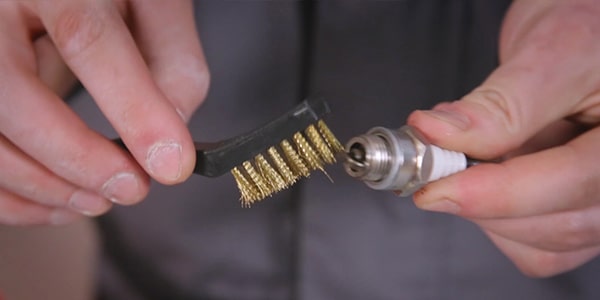
The spark plug is screwed into the cylinder head above the piston cylinder assembly. It allows the combustion of the fuel that comes from the carburetor and passes through the petrol pipe , the valve and the light to then flood the piston chamber.
At one end of the spark plug there is an electrode which, thanks to the electricity supplied by the ignition, produces a spark.
This electrode can get dirty and it is necessary to clean it with a wire brush and then check the distance between the electrodes, about 1mm.
To disassemble it, you must disconnect the spark plug sleeve , then use a spark plug wrench.
Clean the electrodes by removing the residues with compressed air and screwing the spark plug back into the cylinder head by hand before tightening it with the key.
The spark plug is subject to wear and must be changed regularly.
These operations must always be carried out when the chainsaw has been switched off for a certain period of time, the spark plug heats up when the engine is running!
Step 7: Clean the Chainsaw Sprocket
Next, you need to clean the chainsaw sprocket to remove all dirt around the clutch drum and rod bolts.
- The oiler connection must also be cleaned of dirt.
- Use a soft brush to remove all dirt.
- For inner and narrower areas, you can use any other cleaning tool that can easily access the dirt inside.
Step 8: How to Clean a Muffler on a Chainsaw
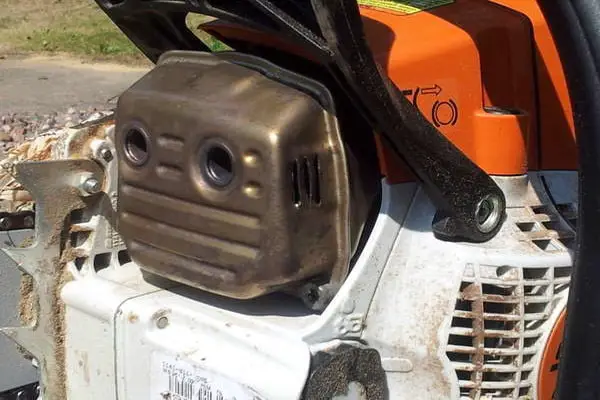
Timely cleaning of the chainsaw silencer can seriously extend the life of the chainsaw. There are several reasons for muffler contamination:
- long service life,
- low quality of the filled oil,
- incorrect carburetor settings
To check the condition of the muffler, you must dismantle it and look inside.
If you need to remove the silencer on the chainsaw , you need to remove the muffler fasteners, the muffler itself, the plate and the reflector.
If you find debris inside the chainsaw muffler, then this problem is solved in two ways:
- Mechanical method (cleaning is carried out with brushes, sandpaper and special products). This path is possible if the muffler is disassembled.
- In the case of a non-separable muffler, special cleaning compounds are used in which the muffler is soaked for several hours.
By correctly performing all the steps, you can easily clean the chainsaw muffler, extend the life of the tool and protect yourself during operation.
Step 9: Clean the Chainsaw Fuel Tank
In addition to regularly cleaning the fuel filter to protect the carburetor from impurities, it is also advisable to empty the gas tank if the chainsaw is not used for a long time, so that deposits do not form.
Most of the chainsaws are equipped with 2-stroke engines, but some chainsaws for professional use are fitted with 4-stroke engines.
For these models it is also necessary to think about a periodic oil change and regular checking of the liquid levels.
Conclusion
Regular cleaning of the chainsaw is important because, especially with a chainsaw that runs on gas, the pollution of the air filter and spark plugs can lead to significant losses in performance, high wear and tear and starting difficulties.
If the chainsaw no longer starts , it is perfect time for cleaning. Also the gumming of the oil pump and the entire chainsaw is prevented so effective.
What can I use to clean my chainsaw?
To clean the chainsaw without much effort use the following materials:
– A basin
– Water
– A degreaser WD-40
– A cloth
– A soft bristle brush
– A WD-40 Multifunction Product
How often should the chain guard be cleaned?
Cleaning the chainsaw chain guard is not an operation that must be done after each use, four times a year is sufficient on average:
1.Remove the plates. Usually sawdust builds up on the sump after a number of uses;
2.Remove sawdust with a brush or a blower depending on what you have available;
3.Wash the chainsaw guard with diesel fuel;
4.Finally, you blow or brush one last time.
How to clean a electric chainsaw?
Electric chain saws are much simpler than gasoline chain saws and therefore much easier to clean.
The most important cleaning activities for these electric chainsaws are:
– Removal of chips and dust (preferably with compressed air, a brush is also possible)
– Cleaning the sprocket area
– Cleaning the rail groove
– Removal of a burr on the rail groove

